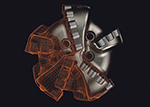Geothermal energy is becoming an increasingly important source of renewable energy as the world seeks to reduce its dependence on fossil fuels and combat climate change.  Geothermal drilling, which involves drilling deep into the earth’s crust to tap into geothermal heat, is a critical component of geothermal energy production. However, geothermal drilling is costly, technically challenging, and requires specialised equipment.
Geothermal drilling, which involves drilling deep into the earth’s crust to tap into geothermal heat, is a critical component of geothermal energy production. However, geothermal drilling is costly, technically challenging, and requires specialised equipment.
One of the most important pieces of equipment for geothermal drilling is the drill bit. Traditional drill bits, specifically Roller Cone, are not well-suited for geothermal drilling, as most are not designed to withstand the high temperatures encountered deep underground and hard rock. However, recent advancements in polycrystalline diamond compact (PDC) drill bit technology, namely design, wear and impact resistance, can help to make geothermal drilling more efficient. However, the challenges are still there: the bit price, bit design and selection can be either cost-prohibitive or lead to significant underperformance.
We are UK-based engineering company, Zerdalab, which is at the forefront of PDC drill bit development for geothermal applications. To reduce the cost and lead time of PDC bits we enable existing localised manufacturing companies to produce the bits close to operations. And to help with bit selection we are developing a Machine-Learning enabled, physics-based process that matches the right cutting structure to the challenges of each individual application, quickly and objectively.
We see and promote the following trends in PDC bits development:
- Localised manufacturing: to help to reduce shipping costs, products cost in most cases, carbon emissions and improve lead times
- Recyclable and reusable materials: Steel-body bits will become a default PDC bit type with advancements of wear and erosion protective coatings and design. Pushing Matrix bits into nish applications
- Rapid repairability: Drill bits are designed to be easily repaired, which reduces downtime and increases drilling cost efficiency
- High temperature enabled instrumentation: To become a mainstream in all drill bits to actively collect downhole data and study drilling dynamics to improve drilling performance and drill bits design
- ML and AI-assisted physics-based match of the bit design to application objectives: To improve speed and objectivity of bits selection and ultimately its performance
 These features are critical for making geothermal drilling more economically viable and reducing the carbon footprint of geothermal operations. By reducing the cost and improving the efficiency of geothermal drilling, PDC drill bits can help to accelerate the growth of geothermal energy production, which is expected to grow at a rate of 9% per year over the next decade.
These features are critical for making geothermal drilling more economically viable and reducing the carbon footprint of geothermal operations. By reducing the cost and improving the efficiency of geothermal drilling, PDC drill bits can help to accelerate the growth of geothermal energy production, which is expected to grow at a rate of 9% per year over the next decade.
According to a report by the International Renewable Energy Agency (IRENA), geothermal energy has the potential to provide up to 3.5% of the world’s electricity by 2050, and could reduce global carbon dioxide emissions by up to 2.5 gigatons per year. In addition, geothermal energy has the potential to create thousands of new jobs and stimulate economic growth in regions with geothermal resources.
Geothermal drilling is going to play a critical role in meeting the world’s growing demand for renewable energy. PDC drill bits designed specifically for geothermal applications, like those being developed by Zerdalab, are helping to make geothermal drilling more efficient, cost-effective, and environmentally responsible. As the world continues to transition to a low-carbon future, geothermal energy will play an increasingly important role, and PDC drill bits will be a critical component of geothermal energy access.
M +44 (0)7549 980407
info@zerdalab.com
www.zerdalab.com


